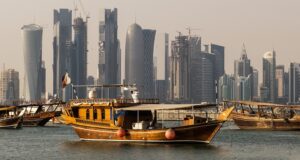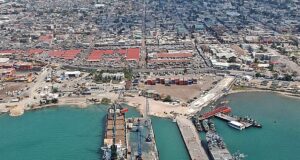Stina Hartikainen – Research Assistant
Policy Unit, 28th October 2014, Issue 10, No. 4.
I. Introduction: Lampedusa and beyond
On 3 October 2013 a boat carrying over 500 migrants from Eritrea and Somalia sunk off the coast of the Italian island of Lampedusa, leading to the deaths of over 350 people; a few days later, a second incident occurred adding at least another 34 lives to the death toll. Following the tragedy of Lampedusa, the EU and its member states pledged that an end must come to migrant deaths in the Mediterranean, with the EU Parliament calling the incidents a turning point towards a new policy guided by ‘solidarity and responsibility’.[1] One year on, the pledge echoes hollow as new reports of incidents across the Mediterranean surface weekly.
In 2014 migrant deaths on the borders of Europe far outnumber previous years, with estimates of over 3,000 fatalities in the first nine months.[2] In September 2014, the humanitarian catastrophe reached new dimensions as reports surfaced of a boat being deliberately sunk by human traffickers, leading to the deaths of over 500 migrants, among them as many as 100 children.[3] The growing migration crisis across Europe once again reached the headlines in the UK as the situation in Calais deteriorated in September with riot police and military being deployed against migrants trying to cross the channel.[4] The UNHCR meanwhile warns that the desperation among migrants is increasing, leading to further risks of accidents, injuries and death.
While the Italian ‘Operation Mare Nostrum’ launched after Lampedusa has prevented the deaths of over 100,000 according to recent estimates, in other parts of Europe the predominant response has been to erect fences and increase border controls in attempts to keep migrants out.[5] Similarly, in an attempt to alleviate the increasingly vocal protests from the leadership in Calais, the British Immigration minister offered to provide relief through fences used during the recent NATO Summit in Wales, a remarkable display of ignorance of the complexity of the situation.[6] While human rights organisations remains critical of establishing screening centres outside the EU, the UNHCR recently suggested it may be the best solution to stall the crisis temporarily and prevent further deaths.[7]
The problem however runs much deeper and involves a number of interrelated elements, from the patterns of contemporary migration and the international legal framework to the potential adverse effects of both policies and legislation currently in place. Europe having recently been designated the most dangerous place in the world for migrants to travel to, it is now imperative to recognise that this is not an issue that will resolve itself or is likely to abate in the foreseeable future.[8] The inefficiency and at times detrimental effects of current EU and member state policy clearly points to the need for a renewed commitment to the promises of ‘never again’ made after Lampedusa.
II. Mediterranean migration: a brief overview
The main routes for Mediterranean migration are through the central and eastern part of the sea, the former often departing from Libya towards Malta and Italy while the latter runs from Turkey along the Adriatic Sea.[9] The increasing use of sea rather than land routes has various explanations. On the one hand, the significant increase of migration along the central Mediterranean route has been partly attributed to the Italian Mare Nostrum Operation, launched following the tragedies of last October. The principal objective of the operation is to prevent deaths at sea and the outspoken practice of saving migrants in distress has been held to encourage both migrants and traffickers to use the sea route. The deteriorating situation in Libya, a transit country for the vast majority of migrants along the central Mediterranean route, has further encouraged risky travel as the danger of remaining in the country continues to increase.[10]
Along the eastern route, the increase in sea borne migration has been attributed in part to tougher border controls, most notably in Greece and Bulgaria, including the building of a fence along the Greek-Turkish border.[11] In Bulgaria, recent reports suggest that the harsh treatment of migrants along with practices of collective expulsion and forced return has discouraged migrants from travelling along the safer land route, instead seeking to make the journey by sea.[12] In addition to potentially violating numerous human rights provisions, the humanitarian implications of State policy against irregular migrants along the South-eastern border of Europe are thus significant.
The countries of origin of the majority of migrants along the central route are Eritrea and Syria, along with Somalia and Mali. The vast majority of migrants departing from Turkey originate in Syria, Afghanistan and Iraq.[13] The countries of origin of the migrants in the Mediterranean reveals that many are fleeing volatile or hostile situations in their home countries, ranging from open conflict in the case of Syria, to persecution and human rights abuses in Eritrea, to general insecurity as for instance in Somalia and Mali. Other groups are economic migrants escaping poverty or unemployment in their countries of origin. Having been described by one Italian official as the ‘exodus of the desperate’,[14] the pattern of mixed migration clearly reflects the complexity of contemporary migration as well as the intimate links between security and development in this regard.
The existence of mixed migration in the Mediterranean also carries significant implications for devising suitable policy. While the patterns of migration and countries of origin to some extent reflects external events over which the EU and its member states have little control, policies focused on keeping migrants out fail to acknowledge the permanent nature of contemporary migration. It needs to be recognised that while the country of origin may shift depending on circumstances, the phenomena as such is unlikely to disappear in the foreseeable future. This has important implications for national and EU policy, especially with regards to the prevalence of a mind-set that prioritises keeping migrants out over more long term solutions.
III. Migrants, refugees and human rights
The international protection of migrants travelling along the Mediterranean routes is derived from various international and regional legal regimes, from the 1951 Refugee Convention to the European Convention of Human Rights and the Law of the Sea. While the latter primarily relates to the direct obligations to act in particular situations of distress and is of general application, the legal framework of rights and obligations once individuals have been rescued extends much further.
The patterns of mixed migration means that the protection status of individuals travelling alongside each other may differ, as refugees often have more extensive rights compared to economic migrants. While the principle of non-refoulment contained in the Refugee Convention only applies to individuals within the legal definition of ‘refugee’[15], protection under international human rights law extends to all individuals under the jurisdiction of one of the signatory states. Of particular importance is the provision against wrongful transfer contained in the UN Convention against Torture. Accordingly, if there are substantial grounds for believing a person will be subject to ill-treatment, the State is under an obligation not to ‘expel, return or extradite’ the individual concerned.[16]
With regards to wrongful transfer, the European Court of Human Rights (ECtHR) has been very clear: if there is a risk of ill-treatment in breach of European human right standards in the recipient country, that ill-treatment is the responsibility of the sending country.[17] This provision is not limited to migrants; nor has it been developed specifically with migration in mind. Nevertheless, it clearly stipulates that even in the absence of refugee status, individuals within the jurisdiction of a signatory state have a right not to be expelled to a country where there is a risk of ill-treatment in breach of basic human rights. In the leading case concerning the practice of push-backs, Hirsi Jamaa v. Italy, the ECtHR reaffirmed these principles and further held that it is the responsibility of each member state to ensure that no such risk exists before a person can be returned.[18] In a recent judgement, the Court indicated that this responsibility also extends to so called Dublin II transfers between EU members.[19]
In addition to the prohibition on return, state parties to the European Convention is also under an obligation to provide adequate and individual screening to determine the legal status of migrants. The fact that not all migrants in the Mediterranean are refugees does not affect the responsibility of recipient states to determine their protection status. Under the European Convention there is a further prohibition on collective expulsion, highlighting the fundamental importance of an individualised determination of status.[20] Mixed migration, while it may lead to different rights once the determination is made, does not absolve EU member states of the procedural obligation of individualised screening. Accordingly, mixed migration cannot serve as a viable excuse for a priori determinations or substandard human rights mechanisms.
IV. A turning point for Europe?
The increasing desperation among migrants in the Mediterranean appears to be coupled with increasing desperation among states and policy makers. Despite the clear determination of push-backs as violating fundamental human rights and the Italian government abandoning the policy, other states appears to have adopted the practice and reports of push-backs of migrants from Greece to Turkey, as well as along the Bulgarian land border, are clearly troublesome.[21] In addition to the risk such practices constitute for individuals, it is also a continuous and systematic violation of human rights. In relation to Greece for example, the EU court has ruled that its practices and treatment of migrants reaches a level of human rights concern sufficient to bar Dublin II returns to the country, a sentiment echoed by the ECtHR.[22]
The signs of desperation can also be detected in the multiplication of fences, walls and increasingly harsh border controls seeking to keep migrants from entering the EU. In addition to the humanitarian implications of such policies as more and more are forced to travel by sea, the responses furthermore fail to acknowledge the complexity of modern day migration, shifting the focus to keeping migrants out rather than devising safer alternatives and long term solutions. The member states on the external borders of the EU are furthermore growing increasingly impatient with the slow responses from Brussels and the lack of either material assistance or wider burden sharing among member states. Aside from the Italian Operation Mare Nostrum, few other states have been involved either directly or indirectly in immediate search and rescue operations.
In Brussels meanwhile the calls for a coordinated policy has only led to partial improvements. In the wake of Lampedusa, the EU strengthened the common border protection agency Frontex and launched a new intelligence and surveillance programme, Eurosur.[23] Following recent developments a new search and rescue operation, Triton, was announced in August 2014, initially with the aim of assisting the Italian operation.[24] More far-reaching policies include the Common European Asylum System seeking to coordinate the asylum policies of EU member states and provide fair and humane treatment of asylum seekers regardless of where they arrive.[25]
There are thus some signs of a coordinated response materialising. On the other hand, seen in light of the scale and severity of the situation over the past months the EU responses appear too little, too late. Increased efforts at preventing accidents and deaths should clearly be the top priority but there is also a need to consider how to provide safer legal alternatives for migrants so that immediate emergencies can be avoided. Furthermore, the much criticised Dublin II regulation appears to be part of the problem rather than the solution. Devised as a means to simplify the asylum process within the EU, Dublin II stipulates that the responsibility for processing an asylum claim falls on the first country where the individual was registered.[26] In practice however this regulation has led to significant side effects, most notably an unwillingness from the states on EU’s external border to accept jurisdiction over migrants and a lack of mechanisms for burden sharing among EU member states.[27] It is therefore necessary to couple the search for more effective short term responses with a wider debate on long term solutions, including a thorough review of the current EU framework.
V. Conclusion
The underlying causes of contemporary migration flows can neither be controlled nor resolved by the EU or its member states alone. War, repression, persecution, poverty, unemployment, disease, degradation. These are not issues that any one actor is either responsible for or able to singularly resolve; they are long-term, entrenched and deep-rooted factors that are, in part, reflected in patterns of contemporary migration. Nonetheless, the crisis in the Mediterranean is about responsibility. It is about solidarity. It is about recognising that the people dying on our shores are fleeing from conditions that most of us are privileged enough to find unimaginable. They endure hardship and ill-treatment on their way here that is an outright insult to all standards of human dignity. The stories that hit the headlines of the capitals of Europe tell us this; the fact that Europe is now the most dangerous place for migrants to reach corroborates it.
Much work is yet to be done in terms of identifying and implementing effective solutions to the crisis in the Mediterranean, both in a short and long term perspective. Opinions will surely differ and it is a process that is likely to take time. Yet this cannot be allowed to overshadow the overarching conclusion that has to be drawn from the catastrophe currently unravelling along our borders. It is, first, foremost and absolutely primarily, about refusing to let more people die in their attempts to reach our soil. It is high time that the EU and its member states, including those not on the external borders of Europe, start delivering on the promise of a migration policy based on solidarity and responsibility.
The migration crisis in the Mediterranean and across Europe is a problem that requires sustained engagement, not just from policy makers and institutions but also from the wider academic community. Therefore, the Human Security Centre will initiate a series of in-depth articles outlining the various dimensions of the current situation, humanitarian, political, legal and strategic, seeking to deepen the understanding not just of the causes of and currents in contemporary Mediterranean migration but also the full range of existing and possible responses, and the potentially adverse effects of inadequate or misdirected policy.
Stina Hartikainen is a Research Assistant and Deputy Group Leader of the Policy Unit with the HSC. Contactable at:
stina.hartikianen@hscentre.org
Cite this article as:
Hartikainen, S. (2014). ‘The Graveyard of ‘Fortress Europe’: Migration crisis in the Mediterranean one year after Lampedusa’, Human Security Centre Policy Brief, Issue 10, No. 4, 28 October 2014.
[1] European Parliament, 23 October 2013 [Link]
[2] BBC, 29 September 2014 [Link]
[3] The Guardian, 16 September 2014 [Link]
[4] The Guardian, 4 September 2014 [Link]
[5] Amnesty International, 29 September 2014, [Link]
[6] The Telegraph, 6 September 2014 [Link]
[7] The Guardian, 2 June 2014 [Link]
[8] International Organization for Migration, 29 September 2014 [Link]
[9] International Organization for Migration, 29 September 2014 [Link]
[10] Spiegel, 15 April 2014 [Link]
[11] The Guardian, 2 June 2014 [Link]
[12] Human Rights Watch, 18 September 2014 [Link]
[13] International Organization for Migration, 29 September 2014 [Link]
[14] Emma Bonino, cited in The Telegraph, 25 August 2013 [Link]
[15] An individual with “a well-founded fear of being persecuted for reasons of race, religion, nationality, membership of a particular social group or political opinion, is outside the country of his nationality, and is unable to, or owing to such fear, is unwilling to avail himself of the protection of that country”.
[16] UN CAT, 1984, Article 3 [Link]
[17] ECtHR Soering v. United Kingdom, 7 July 1989, especially §§86-91 [Link]
[18] ECtHR, 23 February 2012 [Link]
[19] ECtHR, Sharifi and Others v. Italy and Greece 21 October 2014, see also M.S.S. v Belgium and Greece 21 January 2011
[20] Optional Protocol 4, Article 4
[21] Human Rights Watch, January 2013 [Link] and18 September 2014 [Link]
[22] Human Rights Watch, January 2013 [Link]; see also ECtHR M.S.S. v Belgium and Greece, 21 January 2011
[23] European Commission, 4 December 2013 [Link]
[24] Amnesty International, 30 September 2014 [Link]
[25] European Commission, 12 June 2013 [Link]
 Human Security Centre Human Rights and International Security Research
Human Security Centre Human Rights and International Security Research



